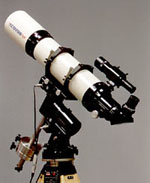 Which telescope is right for you (or for a gift)? The simple answer is the one that will get used and give the most enjoyment. The information on this page should help you to narrow down your search.
Which telescope is right for you (or for a gift)? The simple answer is the one that will get used and give the most enjoyment. The information on this page should help you to narrow down your search.
Please note that ASLC does not advocate for (or profit from) any particular manufacturer. Please also note that this information is by no means complete. Do your homework before investing your money. We highly recommend speaking with our astronomers, and looking through various telescopes before you decide. Visiting our monthly MoonGaze is a great way to look through a number of scopes and get your questions about scope designs and options addressed.
The Basics
Telescopes collect and concentrate light so that the user can see faint objects more easily. Larger aperture (diameter) telescopes collect more light than smaller telescopes allowing you to see fainter objects in greater detail. Light gathering and resolution increase exponentially as aperture increases. A six inch (160mm) scope brings in 4 times the light AND resolves objects 4 times better than a 3 inch (80mm) scope. You actually get a 16 times better view by doubling the aperture. So aperture is a primary consideration in purchasing a telescope. Click here for a simulation of how aperture affects what you'll see through the eyepiece. Additionally, the optics allow the user to magnify objects. More on magnification later.
Some new telescope owners are disappointed when their views through the eyepiece don't look as detailed or as colorful as the pictures on the box or in magazines. You will not see the amazing colors of the Orion or Trifid nebulae through your telescope. You're not going to see the fine detail of the spiral arms of galaxy M101 unless you purchase a very large aperture scope. Those beautiful color images on the product box are possible only with long-exposure astrophotography (and a lot of processing).
Still, viewing distant objects through your telescope with your naked eye can be a very rewarding experience. The Moon, bright planets and star clusters (both open and globular) are particularly enjoyable to view through a telescope. Unlike faint nebulae, star colors are easily discerned in even modest telescopes. Add an ultra-wide angle eyepiece and it can feel like you're floating through spacetime or hovering right over the moon. It's pretty awe-inspiring.
|
|
The Orion Nebula (astrophoto) |
The Orion Nebula (through the eyepiece) |
Part 2 - Types of Telescopes

